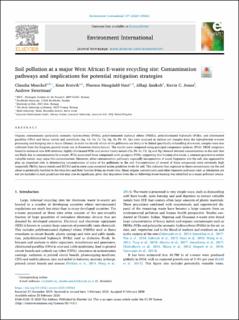| dc.description.abstract | Organic contaminants (polycyclic aromatic hydrocarbons (PAHs), polybrominated diphenyl ethers (PBDEs), polychlorinated biphenyls (PCBs), and chlorinated paraffins (CPs)) and heavy metals and metalloids (Ag, Cd, Co, Cr, Cu, Hg, Ni, Pb, Sb, Zn) were analysed in surface soil samples from the Agbogbloshie e-waste processing and dumping site in Accra (Ghana). In order to identify which of the pollutants are likely to be linked specifically to handling of e-waste, samples were also collected from the Kingtom general waste site in Freetown (Sierra Leone). The results were compared using principal component analyses (PCA). PBDE congeners found in technical octa-BDE mixtures, highly chlorinated PCBs and several heavy metals (Cu, Pb, Ni, Cd, Ag and Hg) showed elevated concentrations in the soils that are likely due to contamination by e-waste. PCAs associated those compounds with pyrogenic PAHs, suggesting that burning of e-waste, a common practice to isolate valuable metals, may cause this contamination. Moreover, other contamination pathways, especially incorporation of waste fragments into the soil, also appeared to play an important role in determining concentrations of some of the pollutants in the soil. Concentrations of several of these compounds were extremely high (especially PBDEs, heavy metals and SCCPs) and in some cases exceeded action guideline levels for soil. This indicates that exposure to these contaminants via the soil alone is potentially harmful to the recyclers and their families living on waste sites. Many organic contaminants and other exposure pathways such as inhalation are not yet included in such guidelines but may also be significant, given that deposition from the air following waste burning was identified as a major pollutant source. | en_US |

